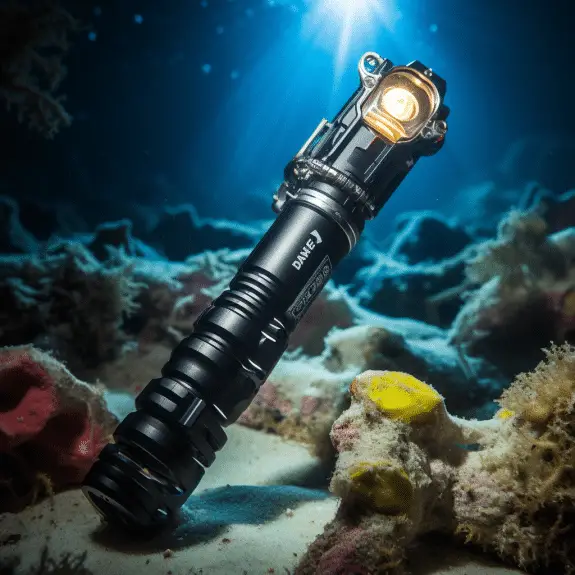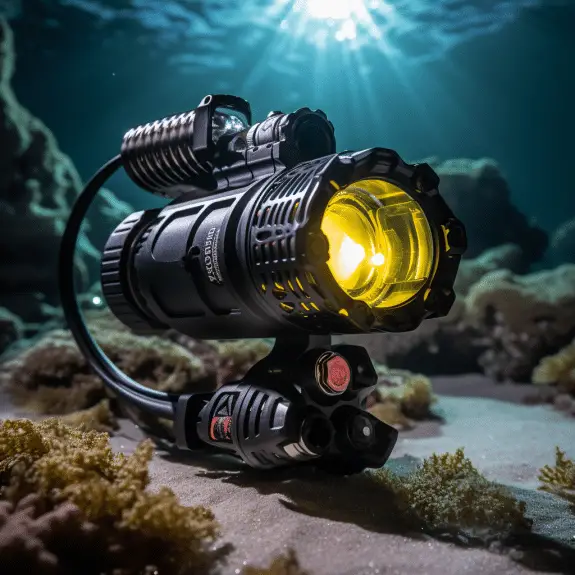Dive lights are an essential accessory for scuba divers, providing illumination in low-light environments such as night dives and wreck exploration. They are also useful for enhancing visibility during the day, allowing divers to peer into cracks and crevices and observe hidden marine life. When choosing a dive light, it’s important to consider factors such as the ruggedness of the case, the ease of use with gloves, the type of batteries, the brightness of the bulbs, and any additional features like multiple power modes and mounts.
Look for high-quality dive lights that are waterproof, durable, and rechargeable for maximum performance and reliability. Consider your diving needs and frequency of use to determine the best dive light for your underwater adventures.
Key Takeaways:
- High-quality dive lights are essential for scuba divers to enhance visibility during underwater adventures.
- Consider factors such as ruggedness, ease of use, battery type, brightness, and additional features when choosing a dive light.
- Look for dive lights that are waterproof, durable, and rechargeable for optimal performance and reliability.
- Choose a dive light that suits your specific diving needs and frequency of use for the best results.
- Consult with dive professionals and read reviews to make an informed decision and find the best dive lights.

Key Features to Consider When Choosing a Dive Light
When selecting a dive light, there are several key features to consider in order to ensure that you choose a durable, waterproof, powerful, and long-lasting option that meets your needs. These features will help enhance your underwater adventures and provide you with a reliable source of light in any diving situation.
1. Rugged and Waterproof Case
A dive light should have a rugged and watertight case that can withstand the pressures of underwater environments. Look for dive lights that are made from robust materials such as aluminum or stainless steel and have high-quality seals to prevent water leakage. A durable and waterproof case will protect the internal components of the dive light from damage and ensure its longevity.
2. Easy-to-Operate Switch
Operating a dive light can be challenging when wearing gloves, so it’s crucial to choose a light with an easy-to-use switch. Look for dive lights that have large buttons or knobs that can be easily manipulated even with gloves on. This feature will allow you to quickly switch the light on and off or adjust the power settings without struggling or wasting valuable diving time.
3. Battery and Bulb Protection
A dive light should have watertight o-ring seals to protect the batteries and bulbs from water damage. These seals create a barrier that prevents water from entering the dive light and causing corrosion or electrical malfunctions. Ensure that the dive light you choose has reliable seals to keep it waterproof and to maintain its performance and functionality in any diving conditions.
4. Size and Carrying Options
The size of the dive light is essential, as it should be easily portable and convenient to use underwater. Look for dive lights that are compact and lightweight, allowing for easy maneuverability and storage. Additionally, consider whether the dive light comes with a wrist lanyard or clip for easy retrieval and attachment to your diving gear. These carrying options will ensure that the dive light is always within reach when needed.
By considering these key features when choosing a dive light, you can select a durable, waterproof, powerful, and long-lasting option that will enhance your underwater adventures and provide you with reliable illumination in any diving situation.
Different Types of Dive Lights and Their Uses
When it comes to dive lights, there are various types available, each with its own unique features and uses. Understanding these different types can help you choose the right dive light for your specific diving needs. Whether you’re a recreational diver, a professional underwater photographer, or an avid cave explorer, there’s a dive light designed to meet your requirements.
Primary Lights
Primary lights are the most common type of dive light and are suitable for general diving purposes. These lights are typically larger in size and offer powerful, wide beams that provide excellent visibility in various underwater conditions. They are ideal for illuminating large areas, such as caves or wrecks, and provide a consistent source of light throughout your dive. Primary lights often come with multiple power modes, allowing you to adjust the brightness according to your needs and conserve battery life.
Backup Lights
Backup lights are smaller, more compact dive lights that are carried as a secondary light source. They are designed to serve as a backup in case your primary light fails or runs out of battery. Backup lights are lightweight and easy to carry, making them convenient for divers who prefer a minimalist gear setup. These lights typically have narrower beams and provide focused illumination for tasks such as reading gauges or signaling your dive buddy.
Mountable Lights
Mountable lights are dive lights that can be attached to various diving equipment, such as masks, wrists, hoses, or camera strobes. These lights offer flexibility in how they are used and allow you to have hands-free illumination while diving. Mountable lights are popular among underwater photographers and videographers who need consistent lighting for capturing clear and vibrant images and videos. They also come in handy for divers who require constant visibility while performing technical tasks or conducting research underwater.
Overall, choosing the right dive light depends on your specific diving requirements and preferences. Whether you opt for a primary light, a backup light, or a mountable light, make sure to select a dive light that is durable, reliable, and meets your desired performance criteria. By investing in a high-quality and suitable dive light, you can enhance your safety, visibility, and overall experience during your underwater adventures.

Conclusion
When it comes to enhancing your underwater adventures, investing in high-quality dive lights is essential. By carefully considering the features and specifications of dive lights, you can ensure optimal performance, durability, and reliability throughout your dives. It’s crucial to select dive lights that are rugged and waterproof to withstand the pressures of underwater environments.
Choosing the right type of batteries and bulbs is also important. Look for dive lights that offer brightness and power modes that suit your specific needs. Additionally, consider any additional features that may enhance your diving experience, such as multiple power modes or mounts for convenient carrying.
Consulting with dive professionals and reading reviews can provide valuable insights and help you make an informed decision. By selecting the best dive lights for your underwater adventures, you can illuminate your exploration, enhance visibility, and capture the breathtaking beauty of the underwater world. Don’t settle for anything less than the best dive lights to ensure an extraordinary diving experience.
FAQ
What factors should I consider when choosing a dive light?
When choosing a dive light, it’s important to consider factors such as the ruggedness of the case, the ease of use with gloves, the type of batteries, the brightness of the bulbs, and any additional features like multiple power modes and mounts.
What features should I look for in a dive light?
Look for dive lights with a rugged and watertight case, an easy-to-operate switch, watertight o-ring seals, a wrist lanyard or clip, powerful beams, a variety of power modes, and options for rechargeable or disposable batteries. Consider if you need a handle or mount and if you require additional marker lights for safety.
What are the different types of dive lights and their uses?
Dive lights come in various styles including primary lights, backup lights, and mountable lights. Primary lights are larger and have wide beams for general use and exploration. Backup lights are smaller and have narrower beams for use as a secondary light. Mountable lights can be attached to masks, wrists, hoses, or camera strobes for added convenience. Rechargeable dive lights are cost-effective and environmentally friendly, while high-performance dive lights offer maximum brightness and advanced features.
Why is investing in high-quality dive lights important?
Investing in high-quality dive lights ensures optimal performance, durability, and reliability during your underwater adventures. By choosing dive lights with the right features and specifications, you can enhance visibility, capture the beauty of the underwater world, and have a more enjoyable diving experience.
